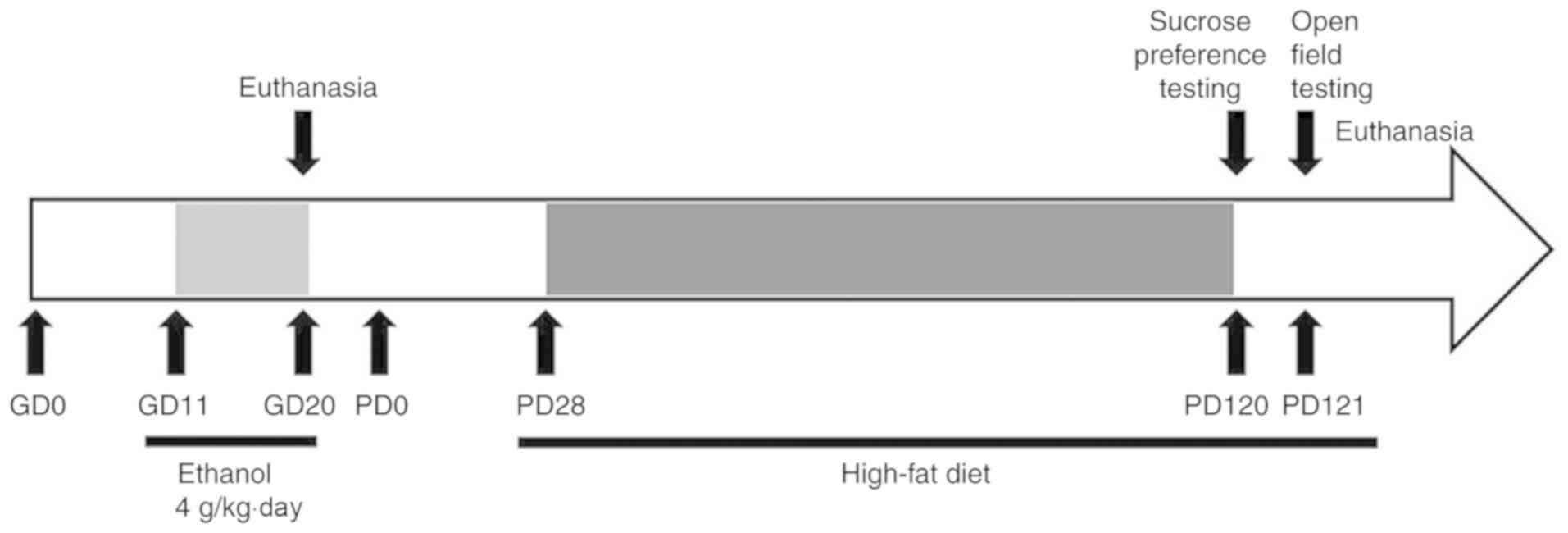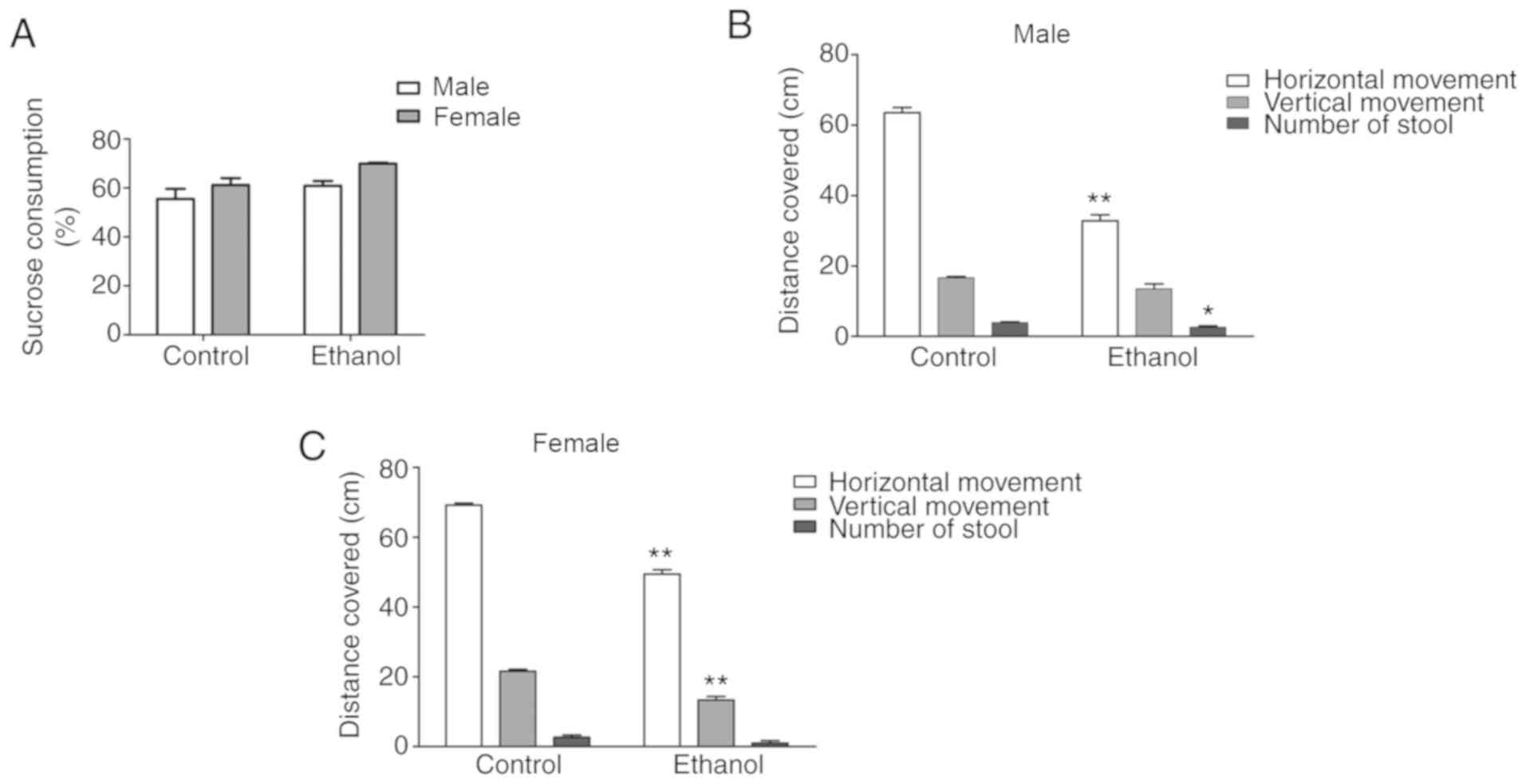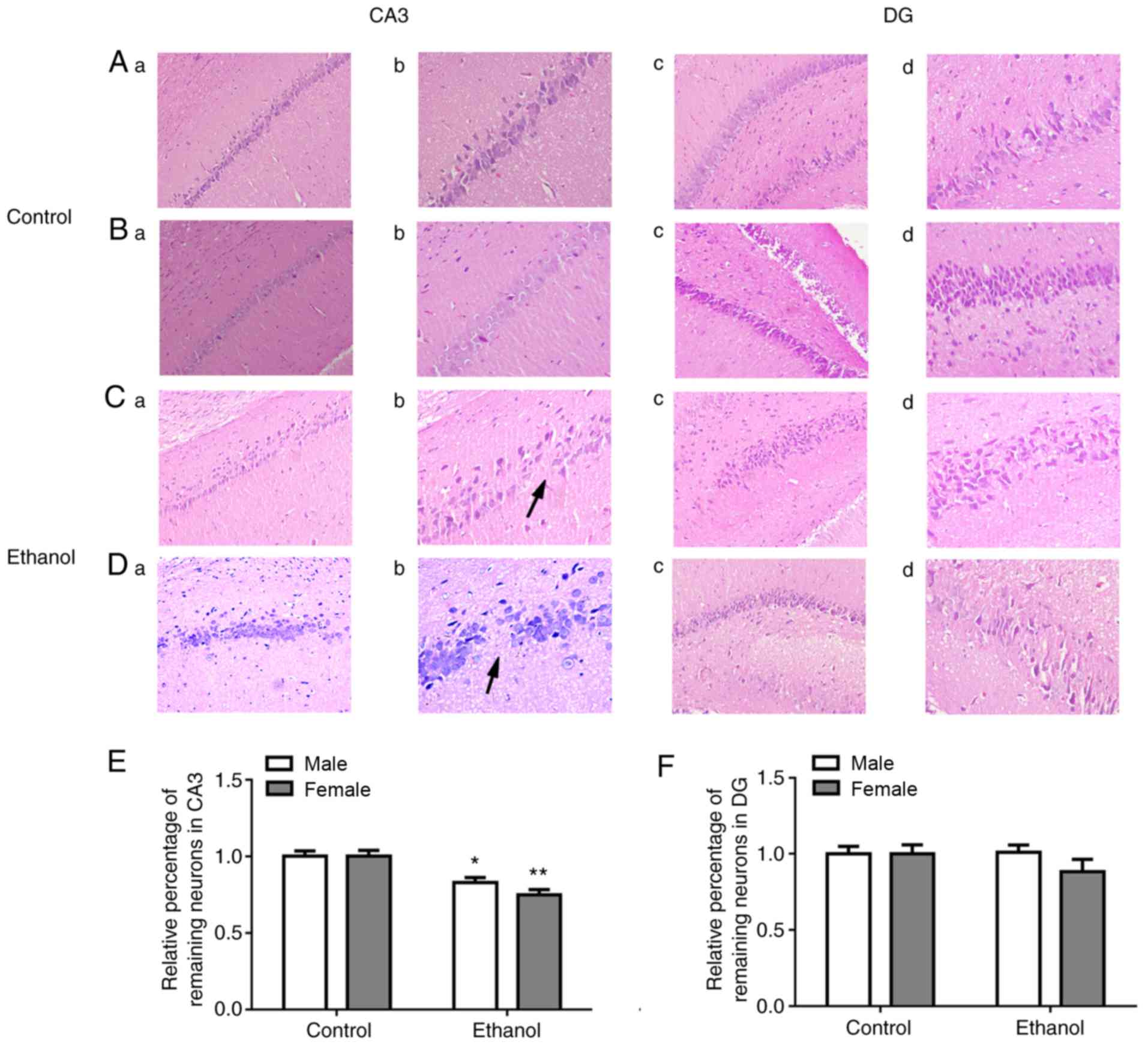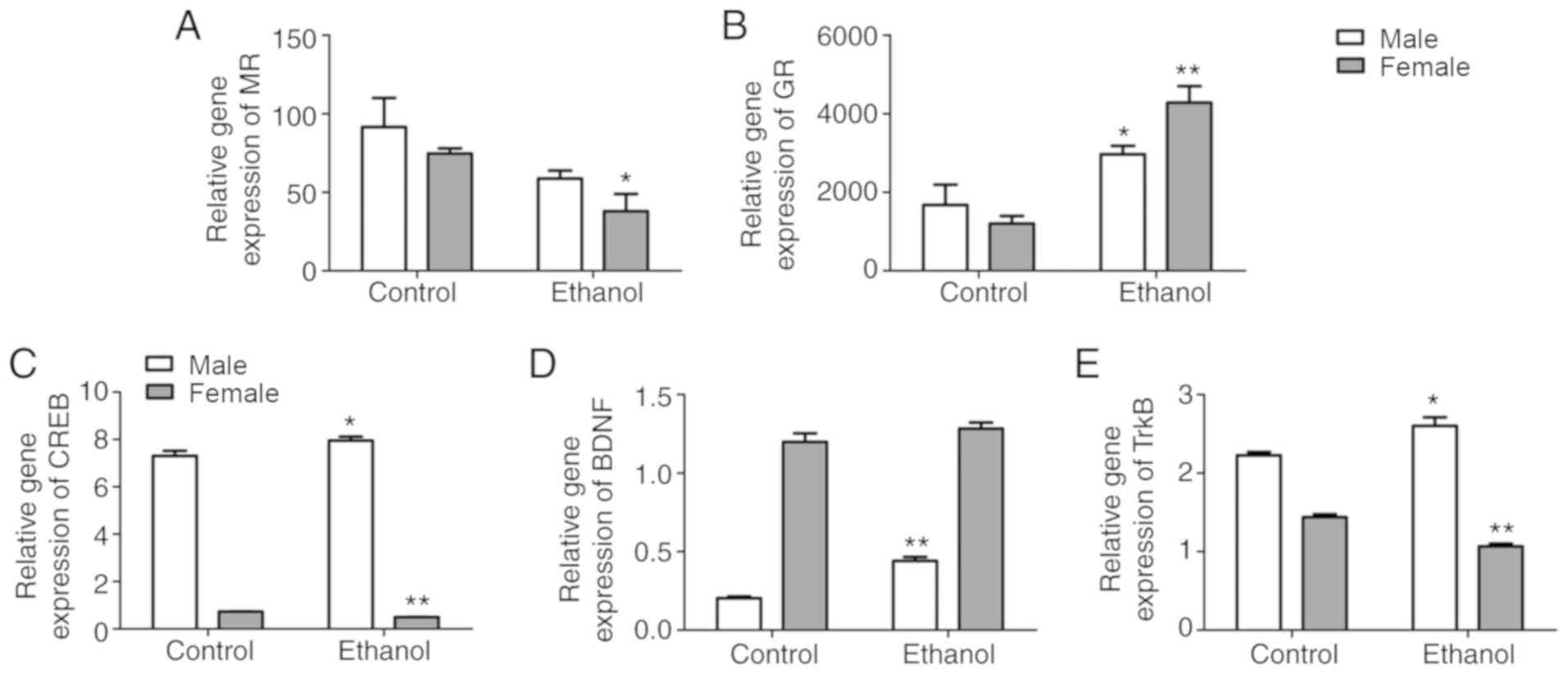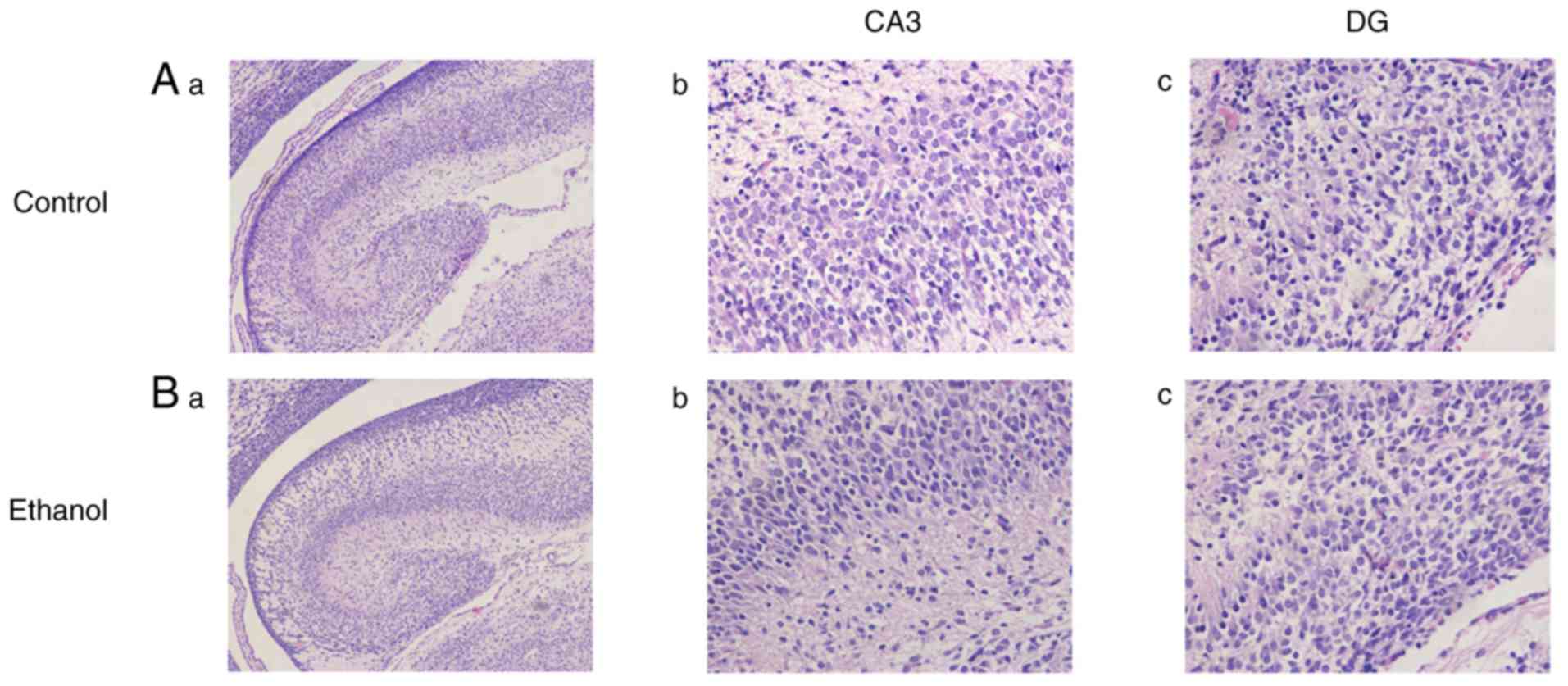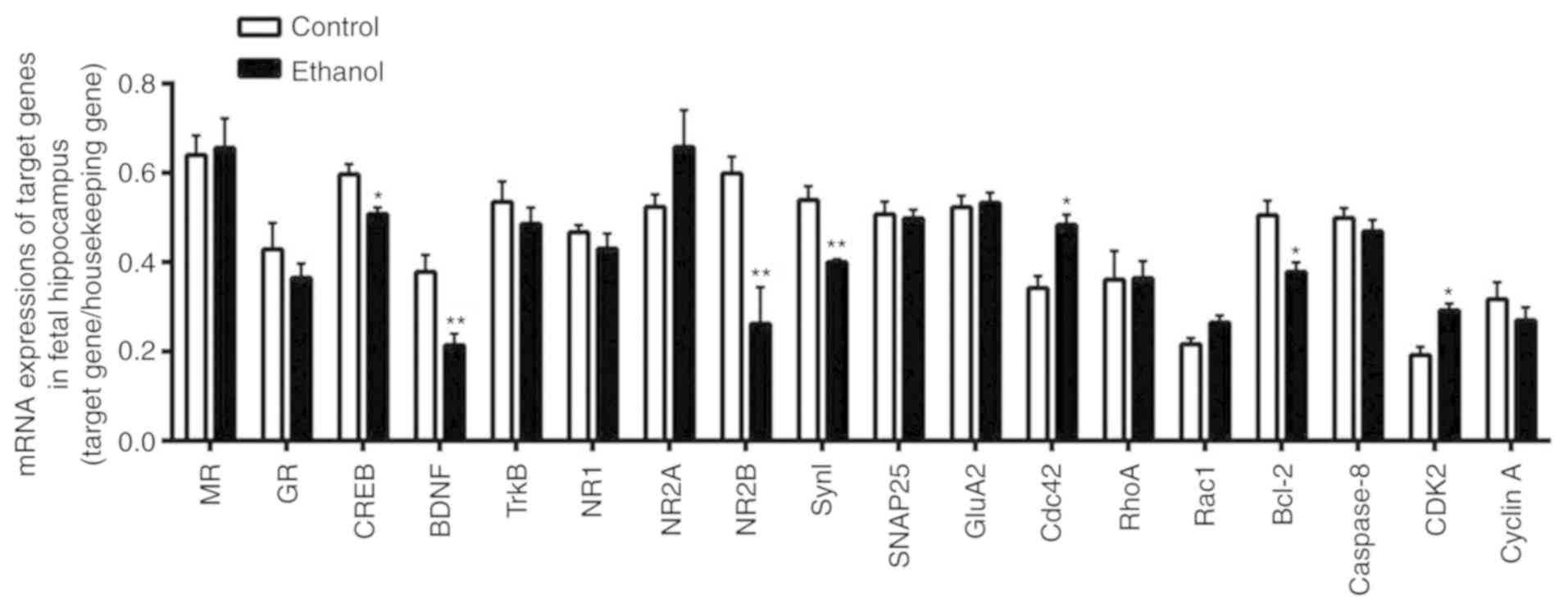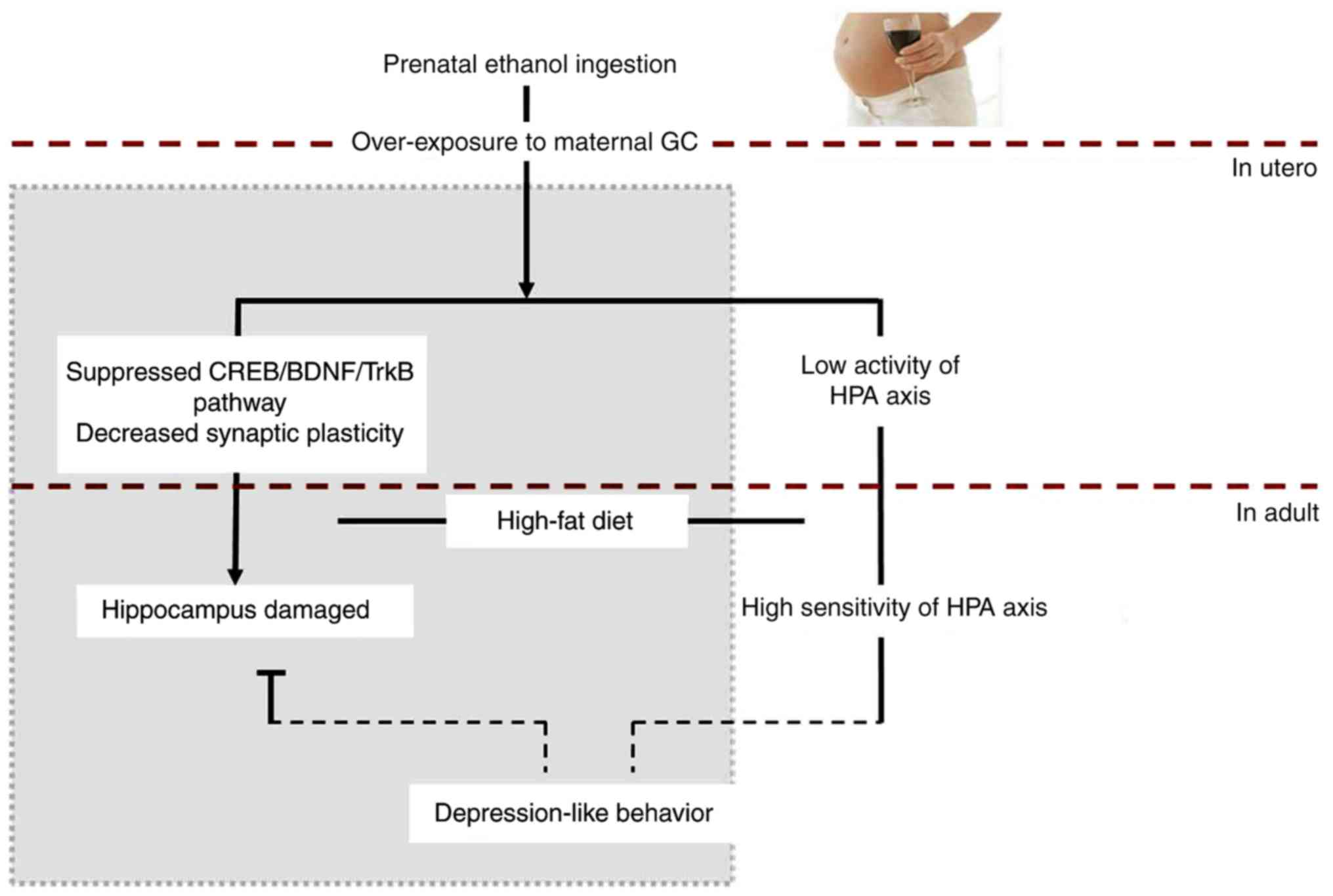Prenatal ethanol exposure enhances the susceptibility to depressive behavior of adult offspring rats fed a high‑fat diet by affecting BDNF‑associated pathway
- Authors:
- Published online on: December 19, 2019 https://doi.org/10.3892/ijmm.2019.4436
- Pages: 365-374
-
Copyright: © Yu et al. This is an open access article distributed under the terms of Creative Commons Attribution License.
Abstract
Introduction
Epidemiological studies have shown that exposure to ethanol during pregnancy can result in fetal intrauterine growth retardation (IUGR) and an increased risk for depression in offspring (1-3). Adults with fetal alcohol effects who were older than 18 years of age were more likely to suffer from a substantial mental illness, and 11 of the 25 subjects were diagnosed as having depression (1). The surveys suggest that offspring exposed to alcohol in utero are more susceptible to depression, and that some types of depression might have a fetal origin. Currently, it is widely recognized that the pathogenesis of depression is influenced by genetic factors and biochemical abnormalities (4,5). However, the intrauterine programming mechanisms that increase the susceptibility of prenatal ethanol exposure (PPE) adult offspring to depression have not been thoroughly investigated.
Brain-derived neurotrophic factor (BDNF), one of the important neurotrophic factors in the brain, is widely expressed in the central nervous system of both developmental stage and adult mammals, with the highest expressions being found in the hippocampus and cortex. BDNF promotes neuronal survival, as well as the differentiation and plasticity of synapses. Some evidence suggests that decreased BDNF in the prefrontal cortex or hippocampus play an important role in depression. Moreover, a growing number of studies have investigated the biological role of BDNF, and a 'BDNF hypothesis' has been proposed to help explain the pathogenic mechanism of depression (4,6). The cAMP response element binding protein (CREB) is an important transcription factor that facilitates the expression of genes that encode for neurotrophic factor and its downstream effector. CREB binds to its binding sites located in the promoter region of the BDNF gene, and thereby promotes BDNF expression (7). Thus, both CREB and BDFN play important roles in depression (8,9). Tyrosine kinase receptor B (TrkB), a high-affinity membrane receptor, binds BDNF, and then exerts multiple biological effects by activating mitogen-activated protein kinase/extracellular signal-regulated kinase (the multiple signaling MAPK/ERK cascade), phosphatidylinositol 3-kinase, and phospholipase C (10). In addition to being a target of CREB, BDNF can itself recruit this particular transcription factor via BDNF/TrkB-mediated signaling enabled by the stimulation of ERK, which subsequently leads to CREB activation. As a result, the expression of BDNF and its related pathways are strongly associated with the pathogenesis of depression. However, it remains unclear whether BDNF is involved in the increased susceptibility to depression found among adult offspring exposed to ethanol in fetus, and if so, what the possible mechanism might be.
This study was designed to verify the enhanced susceptibility to depression in PEE offspring rats by detecting depressive behavior. We also explored possible intrauterine programming mechanisms for increased susceptibility to depression by examining the expression of genes related to the BDNF signaling pathway in the hippocampus of PEE offspring both before and after birth. Our results provide theoretical and experimental evidence that can be used for the early prevention and treatment of depression.
Materials and methods
Animals and treatment
The study protocol was approved by the Committee on the Ethics of Animal Experiments of the Wuhan University School of Medicine (Hubei, China). Experimental procedures conducted on animals were performed in accordance with the 'Guidelines for the Care and Use of Laboratory Animals' published by the Chinese Animal Welfare Committee, and guidelines created by the International Council on Research Animal Care.
Wistar rats (weights of 200-240 g for females and 260-300 g for males) were acclimated and housed under controlled conditions of 18-22°C, 40-60% humidity, and allowed to mate. Gestational day (GD) 0 was defined as the day on which mating could be confirmed by the appearance of sperm in a vaginal smear. Pregnant rats were randomly assigned to an ethanol group and a control group, separately being given ethanol (4 g/kg/day) and the same volume of distilled water by gavage administration from GD11 to GD20. Eight randomly selected pregnant rats with 8-14 live fetuses in each group were euthanized on GD20. In each group, five whole fetal brains were randomly selected and routinely fixed for histologic and ultra-structural examinations; while 8 fetal hippocampus isolated under a dissecting microscope were collected for gene expression analyses. The remaining pregnant rats were maintained until achieving a normal delivery (GD21). On postnatal day 1 (PD1) the number of pups in each group was normalized to 8 pups per litter to ensure that adequate and standardized nutrition could be maintained until weaning at PD28. At PD28, one male and one female offspring rat randomly selected from 22 liters (11 liters from control and 11 liters from PEE) were assigned to four groups (control male/female groups versus PEE male/female groups, n=11 for each group). All offspring rats were given a high-fat diet composed of 0.5% (w/w) cholesterol, 11.5% (w/w) lard, and 88.0% (w/w) cereal. After performing behavior tests at PD120 (sucrose preference test) and PD121 (open field test), the offspring rats was decapitated for histological examination and gene expression analyses (Fig. 1).
Sucrose preference test and open field test
The methods used for assessing sucrose preference and open field tests were modified from those described by Briones et al (11). For the sucrose preference test, the rats were acclimated to making one of a two-bottle choice of either drinking water or a 1% sucrose solution for 2 days. On the day of testing, two pre-weighted bottles, one containing 5% sucrose solution and the other containing tap water, were presented. To prevent any possible effects of side preference on drinking behavior, the positions of the bottles were switched after 12 h of testing. The amount of liquid consumed from each bottle, corrected for body weight, was calculated at the end of a 24-h test period. Sucrose preference was calculated using the equation: Sucrose preference (%)=sucrose intake/(sucrose intake + water intake) ×100. The open field test was conducted on the day after the sucrose preference test, and using a black plexiglas square box (100×100×50 cm). The box was divided into two areas consisting of a peripheral area and a center area (60×60 cm each), both of which were cleaned with 70% ethanol after each rat was tested. During testing, each rat was placed in the center area, then allowed to freely explore for 10 min. Activity in the open field was recorded with a video recorder.
Histological examination
The brain of each adult offspring rats was fixed overnight in 4% paraformaldehyde solution, then processed using the paraffin sectioning technique. The sections (5 µm) were stained with hematoxylin and eosin (H&E) and photographed with an Olympus AH-2 light microscope (Olympus). The total number of neurons was estimated by applying the optical fractionator method (12). The boundaries of the hilus of the DG and of the CA3 and CA1 hippocampal fields were consistently defined at all levels along the rostrocaudal axis of the brain on the basis of cell morphology and cytoarchitectonic criteria (13). The number of cells/mm was counted from three sections (separated by approximately 400 µm) for each animal, and the relative percentage of neurons loss compared with the same region in control group was calculated.
Ultrastructural analysis
The hippocampus was removed and force-fixed in 2.5% glutaraldehyde, then post-fixed in 1% OsO4. The tissue specimens were dehydrated and embedded. Ultrathin sections were stained with 4.7% uranyl acetate and lead citrate. Images were captured by a Hitachi H600 transmission electron microscope (Hitachi).
RT-qPCR
Detail protocols for RT-qPCR were provided in our previous study (14). Briefly, total RNA was isolated from hippocampus tissue using TRIzol reagent according to the manufacturer's protocol. Single-strand cDNA was prepared from total RNA according to a protocol included with the Exscript RT reagent kit (Takara Biotechnology). The primer sequences are shown in Table SI. Relative standard curves were constructed for specific rat target genes, including mineralocorticoid (MR), glucocorticoid (GR), CREB, BDNF, and TrkB, as well as for the housekeeping gene glyceraldehyde phosphate dehydrogenase (GAPDH). PCR assays were performed in 36-well optical reaction plates using a RG-3000 Rotor-Gene 4 Channel Multiplexing system (Qiagen). The mRNA level of the housekeeping gene GAPDH was measured and used as a quantitative control. The expression levels of the above genes were calculated using the 2−∆∆Cq method (15). The PCR cycling conditions are shown in Table SI.
Multiplex analysis of gene expression
A multiplex analysis of two housekeeping genes and 18 target genes was performed using a GenomeLab GeXP Genetic Analysis system (Beckman-Coulter). A multiplex optimization procedure (e.g., primer validation and attenuation) was completed according to the manufacturer's instructions. The target genes and primer pairs analyzed in the study are shown in Table SII. The genes include MR, GR, CREB, BDNF, TrkB, NMDA glutamate receptor subunit 1 (NR1), glutamate NMDA receptor subunit 2A (NR2A), glutamate NMDA receptor subunit 2B (NR2B), glutamate AMPA receptor subunit 2 (GluA 2), GAPDH, synapsin I (Syn 1), synaptosomal-associated protein 25 (SNAP25), cell cycle protein A (Cyclin A), Ras homolog gene family members A (RhoA), ras-related C3 botulinum toxin substrate 1 (Rac1), cell division cyclin 42 (Cdc42), cyclin-dependent kinase 2 (Cdk2), B cell lymphoma/leukemia 2 gene (bcl-2), and rattus norvegicus tubulin, beta 3 (Tubb3). The relative levels of RNA expression were calculated relative to pooled RNA standard and were normalized to the levels of GAPDH and Tubb3 RNA expression.
Statistical analysis
The data are presented as the mean ± SEM. Statistical analyses were performed with the software SPSS 17.0 (SPSS, Inc.). Comparisons between two groups were performed using Student's t-test. Comparisons among more than two groups were conducted by one-way analysis of variance followed by a post hoc Dunnett's test. Statistical significance was designated at P<0.05.
Results
Behavioral changes in adult offspring
To assess depression-like behavior, the adult offspring rats were assessed using the sucrose preference test and open-field test. When compared with the control group, the PEE group had no significant reduction in sugar intake, and there was no difference in sugar intake between sexes (Fig. 2A). In the open-field test, the male PEE offspring displayed significantly reduced horizontal movement (P<0.01), and the female PEE offspring displayed significantly reduced horizontal and vertical movement when compared with offspring in the control group (P<0.01) (Fig. 2B and C). The male PEE offspring had significantly fewer stools than control group (P<0.05); however, there was no difference in stool number between female PEE offspring and control group (Fig. 2B and C).
Histological changes in adult offspring hippocampus
The sections stained by H&E showed that hippocampal pyramidal cells in the adult offspring rats of control group were thick, intact, had sharp edges, and displayed a neat, tight arrangement, with no differences between sexes (Fig. 3A and B). By contrast, the hippocampal pyramidal cells in PEE adult offspring rats were sparse and thin, displayed a loose, disordered arrangement, showed wrinkled nuclei, and were deeply stained. Additionally, fewer pyramidal cells, especially in the Cornu Ammonis (CA) 3 region of the hippocampus, and worse morphology of hippocampus in female rats than male rats were identified (Fig. 3C and D). Based on the quantitative analysis of remaining neurons in CA3 and DG region, the loss of neurons in CA3 has significant differences in female and male offspring rats (P<0.01 and P<0.05) compared with the control group (Fig. 3E). In addition, there was no difference of remaining neurons in DG region between the two groups (Fig. 3F).
MR, GR, CREB, BDNF, and TrkB expression in adult offspring hippocampus
When compared with the control group, mRNA expression of MR in the hippocampus of PEE female offspring rats was significantly decreased (P<0.05); however, no changes were found in the PEE male offspring rats. mRNA expression of GR in the hippocampus of both female and male PEE offspring were significantly increased when compared to the control group (P<0.05 and P<0.01, respectively) (Fig. 4A and B). Furthermore, mRNA expression of hippocampal BDNF in the PEE female offspring and control group were similar; however, the mRNA expressions of CREB and TrkB in the hippocampus of PEE female offspring were much lower than those of the control group (P<0.05 and P<0.01, respectively). Moreover, the mRNA expression of CREB, BDNF and TrkB in the hippocampus of PEE male offspring was significantly increased when compared with those in the control group (P<0.05 or P<0.01; Fig. 4C-E).
Histological changes in fetal hippocampus
H&E staining revealed that the fetal hippocampus of PEE group were similar with the control group in terms of their overall shape, size, cellular structure, and morphology (Fig. 5).
Ultrastructural changes in fetal hippocampal neurons
It was observed by transmission electron microscopy that hippocampal neurons of fetal rats in the control group had an intact nuclear membrane and contained abundant and normal organelles (e.g., mitochondria and endoplasmic reticulum) in the cytoplasm (Fig. 6A). However, several hippocampal neurons in the PEE fetal rats displayed Golgi hypertrophy (Fig. 6B) and extensive rough endoplasmic reticulum cavities (Fig. 6C).
Multi-gene expression analysis of the fetal hippocampus
An analysis was performed using the GenomeLab GexP Genetic Analysis System to detect the expression of genes thought to be closely associated with signal transduction and functional changes in fetal hippocampus. The mRNA expression levels of BDNF and CREB in the fetal rat hippocampus were significantly decreased in the PEE group when compared with those in the control group (P<0.01 and P<0.05, respectively), while TrkB mRNA expression was not significantly different between the two groups. We also analyzed the mRNA expression levels of synaptic protein in the hippocampus of fetal rats. The results showed that the mRNA expression levels of NR2B and Syn I were significantly decreased in the PEE group when compared with those in the control group (P<0.01), while mRNA expression for NR1, NR2A, SNAP25, and GluA2 was not significantly different between the two groups. Furthermore, the mRNA expression levels of MR and GR, which assist in regulating the hypothalamic-pituitary-adrenal (HPA) axis, showed no significant difference between the two groups (Fig. 7).
The GenomeLab GexP Genetic Analysis System was also used to detect the expression of genes related to cellular composition, cell cycling, and apoptosis. Compared with control group, the expression of Cdc42 and CDK2 mRNA in the fetal rat hippocampus were significantly increased in the PEE group (P<0.05), while cyclin A mRNA expression showed no significant difference between the two groups. Moreover, the mRNA expression of Rac1 and RhoA, which assist in cytoskeleton formation, showed no difference between the two groups. Additionally, Bcl-2 mRNA expression, which inhibits apoptosis in the fetal rat hippocampus, was significantly decreased in the PEE group when compared with the control group (P<0.05), while there was no difference of caspase 8 mRNA expression between the two groups (Fig. 7).
Discussion
Depression is a heterogeneous clinical disorder, and its cause remains unclear. The main symptoms displayed by patients with depression are a depressed mood, impotence, anhedonia, and cognition impairment (16). The open-field and sucrose preference tests have been widely used to detect abnormal animal behaviors, and to evaluate the main characteristics of depression, such as lack of interest, anhedonia, and despair behavior. Horizontal movement in the open-field test reflects the activity of animal, and vertical movement reflects its curiosity for the new environment. The sucrose preference test can effectively detect the presence or absence of anhedonia (17,18). In the present study, we observed that after being fed a high-fat diet, the independent activity of PEE offspring gradually decreased, their dynamic performance and exploratory behavior was reduced, and they appeared sluggish with rigid behavior. The statistical analysis revealed that female PEE adult offspring rats showed reduced horizontal and vertical movement in the open-field test, suggesting that the reduced mobility and interest in their environment reflected depression-like behavior in the PEE offspring rats. However, the male PEE adult offspring rats only showed reduced horizontal movement in the open field test, and their depression-like behavior was not obvious. These results suggest a sex difference in the susceptibility of PEE offspring rats to depression. Moreover, we observed that the hippocampal pyramidal cells of PEE adult offspring rats were thin, loose, disordered, and sparse, and that a few cells were even missing. These findings were especially significant in the CA3 region of the hippocampus, where the female offspring rats showed worse morphology than males, and to some extent consistent with the sex difference of depression behavior in PEE offspring rats.
Our previous findings showed that PEE inhibits the development of fetal HPA axis, resulting in low activity levels and high sensitivity to stress exerted on the HPA axis after birth in offspring rats (19). Higher activity and sensitivity of the HPA axis is thought to play an important role in the occurrence of depression (20,21). It is also known that a high-fat diet can increase the HPA axis activity (22,23). Thus we fed offspring rats with a high-fat diet to increase the activity of their HPA axis. We observed that the female PEE offspring rats have more obvious depression-like behaviors when compared with their males, which is consistent with the higher incidence of clinical depression found among female human subjects. Our previous findings also showed that the effect of a high-fat diet on glucose and lipid metabolism was sex-specific, in terms of its ability to induce changes in insulin and adiponectin signaling pathways (24). High-fat diet-induced HPA axis-associated neuroendocrine dysfunction is more severe in female rats than males, as it reduces the expression of GR in the hypothalamus (25). This finding suggests that the HPA axis in females is more sensitive to a fat-induced nutritional imbalance. Moreover, Hill et al suggested that maternal separation produces sex-specific long-term effects on BDNF expression and signaling, and that alterations in BDNF signaling might mediate the sex-specific effects of developmental stress on anhedonic behavior (26). Therefore, we speculated that PEE-induced changes in HPA axis programming and the BDNF signaling pathway may both be involved in sex differences regarding depression-like behavior among PEE adult offspring rats fed a high-fat diet.
CREB, an important transcription factor, is involved in the transcription of BDNF. Previous results showed that among suicide victims, depression was accompanied by reduced expression and activation of CREB (27,28). Inactivation of CREB reduces the levels of BDNF expression, which can lead to depression-like behavior and a weakened effect of antidepressant drugs (7,9,29). Related clinical research has confirmed the presence of significantly reduced BDNF levels in the blood of normal individuals prone to depression and patients with depression. Certain antidepressant treatments might significantly increase the levels of BDNF in the blood of patients with depression (30). Previous study also revealed decreased levels of BDNF expression in the hippocampus of rats which displayed depression-like behavior (31). It is possible that an oriented injection of BDNF into an animal's hippocampus might provide an antidepressant effect (7). Another study showed that oriented knockout of the BDNF gene in the dentate gyrus resulted in decreased hippocampal neurogenesis and led to obvious depressive behavior (32). Additionally, mice with a mutant BDNF gene also showed obvious depressive behavior (33). TrkB is a BDNF receptor, and studies have suggested that BDNF and TrkB mRNA and protein expression are decreased in the hippocampus and other brain regions of depressed individuals, as well as suicide victims (33-37). All of these studies suggest that reduced levels of BDNF and BDNF signaling activity in the hippocampus are closely associated with the occurrence of depression.
Caldwell et al reported that adult offspring mice exposed to ethanol throughout gestation displayed depressive-like behaviors, which were associated with reduced levels of BDNF protein and mRNA in the hippocampus and frontal cortex (38). Our study found that adult offspring rats that had been exposed to ethanol during the middle-late stage of pregnancy (GD11-20) displayed depressive-like behaviors, thereby confirming the observation of Caldwell. Differently, we fed the PEE offspring a high-fat diet after weaning, and then examined changes in the expression of BDNF-related signaling in the hippocampus. We found that it has no difference between the BDNF mRNA expression in the hippocampus of female PEE offspring rats and those in control rats; however, the expression of CREB and TrkB mRNA in the female PEE offspring were significantly decreased. These results suggest that the BDNF pathway in the hippocampus of adult female PEE offspring was in an inactivated state, which might be the main cause for those rats with depression-like behavior.
We used PEE fetal rats as a model in which to identify a possible intrauterine mechanism for depression-like behavior and a damaged hippocampus in adult PEE offspring rats. We found that some fetal hippocampal neurons in the PEE group showed Golgi hypertrophy and an extensive rough endoplasmic reticulum cavity. Additionally, we examined the expression of BDNF pathways in PEE offspring during their intrauterine period. Results of a multi-gene expression analysis of the fetal hippocampus revealed that the levels of BDNF and CREB mRNA expression, as well as the expression levels of synaptic plasticity-related genes NR2B and Syn I, were significantly lower in the PEE group when compared with those in the control group. Our results suggest that the depression-like behavior might be associated with weakened expression of the BDNF pathway and impaired neural synaptic plasticity in the hippocampus during the intrauterine period in PEE adult offspring rats. We also found increased expression of genes involved in cell proliferation and apoptosis in the fetal hippo-campus, but did not find significant changes in the expression of cytoskeleton-related genes. These findings suggest that the rates of cell proliferation and apoptosis in PEE fetal rat hippocampal neurons were higher than normal, possibly as a result of ethanol exposure.
In a previous study, we found that PEE induced IUGR, and led the fetus overexposure to elevated levels of maternal GC (39). GC, an important stress hormone, affects the function of neurons in the central nervous system, and its presence at extra high levels might be related to the pathogenesis of depression (40). When under the influence of high GC levels, MR is quickly saturated and GR becomes activated; furthermore, excessive activation of GR might damage hippocampal neurons and inhibit BDNF expression (41). Both acute and chronic stimulation can significantly reduce BDNF expression in the hippocampus (31). This suggests that in our study, high levels of GC induced increased GR expression in the hippocampus. This increased GR expression blocked the BDNF-mediated MAPK/ERK signaling pathway, resulting in damage to neurons and reduced synaptic plasticity, which influenced the transmission of information by 'neural circuits' and induced the occurrence of depression. Based on results obtained, we speculate that under conditions of intrauterine exposure to high levels of maternal GC as a result of PEE, the hippocampus of the offspring fetus was not damaged, and GR expression remained unchanged. However, at the same time, CREB and BDNF expression were declined, and their functions were restrained, causing neurogenesis and synaptic plasticity being suppressed in fetal hippocampus. Additionally, being fed a high-fat diet in adulthood further aggravated the toxic effects of high GC levels in female offspring rats (26,27), and induced high levels of GR expression, which restrained the BDNF pathway in adult hippocampus. These changes resulted in impaired hippocampal morphology and function, which directly and indirectly increased the susceptibility to depression in offspring rats. In short, the intrauterine mechanism for increased susceptibility to depression among adult PEE offspring is most likely continues suppression of the BDNF pathway from fetus to adult.
In conclusion, our data indicated that PEE is capable of inducing depression-like behavior in adult offspring rats fed a high-fat diet, and especially in female offspring (Fig. 8). PEE resulted in overexposure of the fetus to maternal GC, and inhibited the expression of CREB and its target gene BDNF in the fetal hippocampus. This inhibition led to an alteration of HPA axis programming and suppressed function of the HPA axis in fetal rats. These effects continued until birth, and even into adulthood. The high-fat diet fed after birth and the high excitability of the HPA axis caused elevated expression of hippocampal GR in female offspring, and further inhibited the BDNF pathways in offspring hippocampus. This could result in reduced levels of neurogenesis and synaptic plasticity in hippocampus, which eventually caused depression-like behavior in the female offspring rats.
Supplementary Data
Acknowledgments
Not applicable.
Funding
This study was supported by grants from the National Science and Technology Pillar Program of China (no. 2013BAI12B01-3) and the National Natural Science Foundation of China (nos. 81300984, and 81430089).
Availability of data and materials
The analyzed data sets generated during the study are available from the corresponding author on reasonable request.
Authors' contributions
YY and HW conceived and designed the study. YY, DX, SC, LZ, ZS, JQ and ZZ performed the experiments, and acquired, analyzed and interpreted the data. YY and HW drafted and edited the manuscript. All authors have read and revised the manuscript.
Ethics approval and consent to participate
The study protocol was approved by the Committee on the Ethics of Animal Experiments of the Wuhan University School of Medicine. All experimental procedures conducted on animals were performed in accordance with 'Guidelines for the Care and Use of Laboratory Animals' published by the Chinese Animal Welfare Committee, and guidelines created by the International Council on Research Animal Care.
Patient consent for publication
Not applicable.
Competing interests
The authors declare that they have no competing interests.
References
|
Famy C, Streissguth AP and Unis AS: Mental illness in adults with fetal alcohol syndrome or fetal alcohol effects. Am J Psychiatry. 155:552–554. 1998. View Article : Google Scholar : PubMed/NCBI | |
|
Sood B, Delaney-Black V, Covington C, Nordstrom-Klee B, Ager J, Templin T, Janisse J, Martier S and Sokol RJ: Prenatal alcohol exposure and childhood behavior at age 6 to 7 years: I. dose-response effect. Pediatrics. 108:E342001. View Article : Google Scholar : PubMed/NCBI | |
|
O'Connor MJ, Shah B, Whaley S, Cronin P, Gunderson B and Graham J: Psychiatric illness in a clinical sample of children with prenatal alcohol exposure. Am J Drug Alcohol Abuse. 28:743–754. 2002. View Article : Google Scholar : PubMed/NCBI | |
|
Duman RS and Monteggia LM: A neurotrophic model for stress-related mood disorders. Biol Psychiatry. 59:1116–1127. 2006. View Article : Google Scholar : PubMed/NCBI | |
|
Levinson DF: The genetics of depression: A review. Biol Psychiatry. 60:84–92. 2006. View Article : Google Scholar | |
|
Nestler EJ, Barrot M, DiLeone RJ, Eisch AJ, Gold SJ and Monteggia LM: Neurobiology of depression. Neuron. 34:13–25. 2002. View Article : Google Scholar : PubMed/NCBI | |
|
Shirayama Y, Chen ACH, Nakagawa S, Russell DS and Duman RS: Brain-derived neurotrophic factor produces antidepressant effects in behavioral models of depression. J Neurosci. 22:3251–3261. 2002. View Article : Google Scholar : PubMed/NCBI | |
|
Liebenberg N, Müller HK, Fischer CW, Harvey BH, Brink CB, Elfving B and Wegener G: An inhibitor of cAMP-dependent protein kinase induces behavioural and neurological antidepressant-like effects in rats. Neurosci Lett. 498:158–161. 2011. View Article : Google Scholar : PubMed/NCBI | |
|
Réus GZ, Stringari RB, Ribeiro KF, Ferraro AK, Vitto MF, Cesconetto P, Souza CT and Quevedo J: Ketamine plus imipramine treatment induces antidepressant-like behavior and increases CREB and BDNF protein levels and PKA and PKC phosphorylation in rat brain. Behav Brain Res. 221:166–171. 2011. View Article : Google Scholar : PubMed/NCBI | |
|
Patapoutian A and Reichardt LF: Trk receptors: Mediators of neurotrophin action. Curr Opin Neurobiol. 11:272–280. 2001. View Article : Google Scholar : PubMed/NCBI | |
|
Briones TL and Woods J: Chronic binge-like alcohol consumption in adolescence causes depression-like symptoms possibly mediated by the effects of BDNF on neurogenesis. Neuroscience. 254:324–334. 2013. View Article : Google Scholar : PubMed/NCBI | |
|
West MJ, Slomianka L and Gundersen HJ: Unbiased stereological estimation of the total number of neurons in thesubdivisions of the rat hippocampus using the optical fractionator. Anat Rec. 231:482–497. 1991. View Article : Google Scholar : PubMed/NCBI | |
|
Amaral DG and Witter MP: Hippocampal formation. The rat nervous system. Paxinos C: 2nd edition. Academic Press Ltd; London: pp. 443–493. 1995 | |
|
Ao Y, Sun Z, Hu S, Zuo N, Li B, Yang S, Xia L, Wu Y, Wang L, He Z and Wang H: Low functional programming of renal AT2R mediates the developmental origin of glomerulosclerosis in adult offspring induced by prenatal caffeine exposure. Toxicol Appl Pharmacol. 287:128–138. 2015. View Article : Google Scholar : PubMed/NCBI | |
|
Livak KJ and Schmittgen TD: Analysis of relative gene expression data using real-time quantitative PCR and the 2(-Delta Delta C(T)) method. Methods. 25:402–408. 2001. View Article : Google Scholar | |
|
Kennedy SH: Core symptoms of major depressive disorder: Relevance to diagnosis and treatment. Dialogues Clin Neurosci. 10:271–277. 2008.PubMed/NCBI | |
|
Overstreet DH: Modeling depression in animal models. Psychiatric Disorders Springer. 125–144. 2012. View Article : Google Scholar | |
|
Yan HC, Cao X, Das M, Zhu XH and Gao TM: Behavioral animal models of depression. Neurosci Bull. 26:327–337. 2010. View Article : Google Scholar : PubMed/NCBI | |
|
Xia LP, Shen L, Kou H, Zhang BJ, Zhang L, Wu Y, Li XJ, Xiong J, Yu Y and Wang H: Prenatal ethanol exposure enhances the susceptibility to metabolic syndrome in offspring rats by HPA axis-associated neuroendocrine metabolic programming. Toxicol Lett. 226:98–105. 2014. View Article : Google Scholar : PubMed/NCBI | |
|
Guerry JD and Hastings PD: In search of HPA axis dysregulation in child and adolescent depression. Clin Child Fam Psychol Rev. 14:135–160. 2011. View Article : Google Scholar : PubMed/NCBI | |
|
Höhne N, Poidinger M, Merz F, Pfister H, Brückl T, Zimmermann P, Uhr M, Holsboer F and Ising M: Increased HPA axis response to psychosocial stress in remitted depression: The influence of coping style. Biol Psychol. 103:267–275. 2014. View Article : Google Scholar : PubMed/NCBI | |
|
Chan O, Inouye K, Riddell MC, Vranic M and Matthews SG: Diabetes and the hypothalamo-pituitary-adrenal (HPA) axis. Minerva Endocrinol. 28:87–102. 2003.PubMed/NCBI | |
|
Shin AC, MohanKumar SM, Sirivelu MP, Claycombe KJ, Haywood JR, Fink GD and MohanKumar PS: Chronic exposure to a high-fat diet affects stress axis function differentially in diet-induced obese and diet-resistant rats. Int J Obes (Lond). 34:1218–1226. 2010. View Article : Google Scholar | |
|
Shen L, Liu Z, Gong J, Zhang L, Wang L, Magdalou J, Chen L and Wang H: Prenatal ethanol exposure programs an increased susceptibility of non-alcoholic fatty liver disease in female adult offspring rats. Toxicol Appl Pharmacol. 274:263–273. 2014. View Article : Google Scholar | |
|
Zhang L, Xu D, Zhang B, Liu Y, Chu F, Guo Y, Gong J, Zheng X, Chen L and Wang H: Prenatal food restriction induces a hypothalamic-pituitary-adrenocortical axis-associated neuroendocrine metabolic programmed alteration in adult offspring rats. Arch Med Res. 44:335–345. 2013. View Article : Google Scholar : PubMed/NCBI | |
|
Hill RA, Klug M, Kiss Von Soly S, Binder MD, Hannan AJ and van den Buuse M: Sex-specific disruptions in spatial memory and anhedonia in a 'two hit' rat model correspond with alterations in hippocampal brain-derived neurotrophic factor expression and signaling. Hippocampus. 24:1197–1211. 2014. View Article : Google Scholar : PubMed/NCBI | |
|
Dwivedi Y, Conley RR, Roberts RC, Tamminga CA and Pandey GN: [3H] cAMP binding sites and protein kinase a activity in the prefrontal cortex of suicide victims. Am J Psychiatry. 159:66–73. 2002. View Article : Google Scholar : PubMed/NCBI | |
|
Pandey GN, Dwivedi Y, Ren X, Rizavi HS, Roberts RC and Conley RR: Cyclic AMP response element-binding protein in post-mortem brain of teenage suicide victims: Specific decrease in the prefrontal cortex but not the hippocampus. Int J Neuropsychopharmacol. 10:621–629. 2007. View Article : Google Scholar | |
|
Zhang LL, Wang JJ, Liu Y, Lu XB, Kuang Y, Wan YH, Chen Y, Yan HM, Fei J and Wang ZG: GPR26-deficient mice display increased anxiety-and depression-like behaviors accompanied by reduced phosphorylated cyclic AMP responsive element-binding protein level in central amygdala. Neuroscience. 196:203–214. 2011. View Article : Google Scholar : PubMed/NCBI | |
|
Sen S, Duman R and Sanacora G: Serum brain-derived neuro-trophic factor, depression, and antidepressant medications: Meta-analyses and implications. Biol Psychiatry. 64:527–532. 2008. View Article : Google Scholar : PubMed/NCBI | |
|
Murakami S, Imbe H, Morikawa Y, Kubo C and Senba E: Chronic stress, as well as acute stress, reduces BDNF mRNA expression in the rat hippocampus but less robustly. Neurosci Res. 53:129–139. 2005. View Article : Google Scholar : PubMed/NCBI | |
|
Taliaz D, Stall N, Dar DE and Zangen A: Knockdown of brain-derived neurotrophic factor in specific brain sites precipitates behaviors associated with depression and reduces neurogenesis. Mol Psychiatry. 15:80–92. 2010. View Article : Google Scholar : | |
|
Sakata K, Jin L and Jha S: Lack of promoter IV-driven BDNF transcription results in depression-like behavior. Genes Brain Behav. 9:712–721. 2010. View Article : Google Scholar : PubMed/NCBI | |
|
Pandey GN, Ren X, Rizavi HS, Conley RR, Roberts RC and Dwivedi Y: Brain-derived neurotrophic factor and tyrosine kinase B receptor signalling in post-mortem brain of teenage suicide victims. Int J Neuropsychopharmacol. 11:1047–1061. 2008. View Article : Google Scholar : PubMed/NCBI | |
|
Thompson Ray M, Weickert CS, Wyatt E and Webster MJ: Decreased BDNF, trkB-TK+ and GAD67 mRNA expression in the hippocampus of individuals with schizophrenia and mood disorders. J Psychiatry Neurosci. 36:195–203. 2011. View Article : Google Scholar : PubMed/NCBI | |
|
Banerjee R, Ghosh AK, Ghosh B, Bhattacharyya S and Mondal AC: Decreased mRNA and protein expression of BDNF, NGF, and their receptors in the hippocampus from suicide: An analysis in human postmortem brain. Clin Med Insights Pathol. 6:1–11. 2013. View Article : Google Scholar : PubMed/NCBI | |
|
Ray MT, Shannon Weickert C and Webster MJ: Decreased BDNF and TrkB mRNA expression in multiple cortical areas of patients with schizophrenia and mood disorders. Transl Psychiatry. 4:e3892014. View Article : Google Scholar : PubMed/NCBI | |
|
Caldwell KK, Sheema S, Paz RD, Samudio-Ruiz SL, Laughlin MH, Spence NE, Roehlk MJ, Alcon SN and Allan AM: Fetal alcohol spectrum disorder-associated depression: Evidence for reductions in the levels of brain-derived neurotrophic factor in a mouse model. Pharmacol Biochem Behav. 90:614–624. 2008. View Article : Google Scholar : PubMed/NCBI | |
|
Liang G, Chen M, Pan XL, Zheng J and Wang H: Ethanol-induced inhibition of fetal hypothalamic-pituitary-adrenal axis due to prenatal overexposure to maternal glucocorticoid in mice. Exp Toxicol Pathol. 63:607–611. 2011. View Article : Google Scholar | |
|
Lam VYY, Raineki C, Ellis L, Yu W and Weinberg J: Interactive effects of prenatal alcohol exposure and chronic stress in adulthood on anxiety-like behavior and central stress-related receptor mRNA expression: Sex-and time-dependent effects. Psychoneuroendocrinology. 97:8–19. 2018. View Article : Google Scholar : PubMed/NCBI | |
|
Suri D and Vaidya VA: Glucocorticoid regulation of brain-derived neurotrophic factor: Relevance to hippocampal structural and functional plasticity. Neuroscience. 239:196–213. 2013. View Article : Google Scholar |



